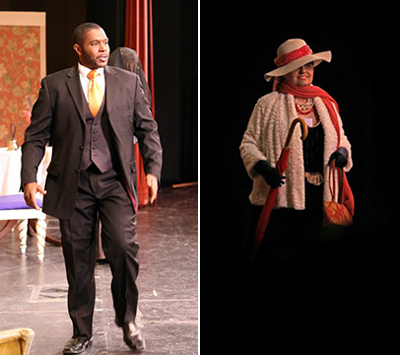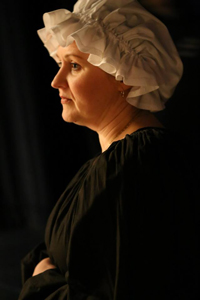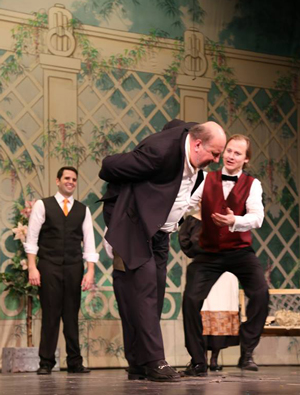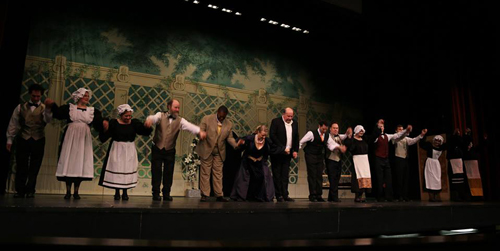by Daniel Hathaway
Gaetano Donizetti’s Don Pasquale centers around the title character’s cynical marriage scheme, designed to disinherit his nephew, Ernesto, who wants to tie the knot with a widow the Don doesn’t like. It doesn’t go well for Don Pasquale, who ends up playing the fool. Although Opera Circle Cleveland’s production on Sunday at the Westlake Schools Performing Arts Center took a while to get funny, strong singing and acting added up to an engaging afternoon of comic opera.
For Don Pasquale, Opera Circle enjoyed the benefit of a fully-equipped theater at the Westlake Schools Performing Arts Center, and a pit large enough to hold the 55-member Cleveland Women’s Orchestra, conducted by Robert Cronquist. Though the company has found imaginative ways to use the limited resources of area churches for its productions, real sets and ample stage space do a lot to ramp up the quality of its performances.

Don Pasquale
Since opera is ultimately all about the singing, being able to field fine soloists can make or break a show. Polish-born bass Pawel Izdebski (above), accustomed at this point in his career to singing roles in Wagner and Strauss, temporarily retooled his resonant voice to take on the buffa role of Don Pasquale. Vocally splendid yet flexible, he found understated ways to make the Don amusing without eroding his inner dignity.

Dr. Malatesta & Norina
Baritone James Binion is a pleasure to hear. He brought a sonorous yet supple voice and an engaging stage presence to the role of Dr. Malatesta (“Dr. Headache”). Busy soprano Dorota Sobieska, Opera Circle’s executive director, who doubled as stage director and Norina, gradually warmed up to Donizetti’s challenging vocal lines, producing several impressive series of high notes. Though lighter of voice than his colleagues, tenor Matthew Miles carried well into the house and fit perfectly into the skin of Ernesto.
Baritone Joel Rhoads did triple duty, playing the Notary and the Majordomo of the Don’s household, as well as joining Tim Hoehler to accompany the garden scene chorus on the guitar. The chorus of a dozen servants added vivacity to several scenes, especially in Act II, when the flood of goods purchased by the Don’s new bride begins arriving and piling up.

Chorus Member
Conductor Robert Cronquist (also credited with the handsome set designs) kept the musical proceedings in good order, though some orchestral sluggishness crept into parts of the first act and bogged down Donizetti’s signature parlando passages (“patter singing”) late in the show. A lovely cello solo in the overture and long stretches of lively, well-balanced playing redeemed other moments when winds went out of tune.

Ernesto, Don Pasquale & the majordomo
Opera buffa needs a special kind of propulsion to keep its story line moving along. A few production efficiencies might have tightened up this three-hour show. Playing Ernesto’s garden soliloquy in front of the curtain with a potted palm or two could have eliminated a whole set change. After the intermissions, long minutes ensued before the curtains parted. On two occasions, those curtains opened on an empty stage while the orchestra played the introduction to the scene.

Serenade in the Garden
And could some interesting onstage business have been crafted during the overture? Donizetti’s audiences were just settling in at that point. Modern audiences sit and listen attentively, but have nothing to watch.
Sobieska’s staging was efficient, though characters often seemed not to have enough to do with themselves, or sang to each other from opposite ends of the set. The Act Two, Scene Two episode where the Don’s bride-to-be appears right out of the convent, veiled and shy, was the funniest moment in a generally delightful show. Barbara Luce’s costumes were well-conceived and colorful, especially for Norina. And has there ever been a better-outfitted corps of house servants, outside of Downton Abbey?

Norina’s good begin arriving
Photos by Adam Simms.
Published on ClevelandClassical.com February 24, 2015.
Click here for a printable copy of this article




